- Lawn Turf
- Artificial
- Soil
- Timber
- Composite Decking
- Paving & Stone
Get In Touch With Our Experts Today!
Give us a Call! - Seed & Fertiliser
- Dressing
- Bark

December 03, 2024
As we move into the final month of the year, there’s still a lot we can do to help our lawns settle down and rest during the winter months. And the more you do for your lawn now, the more you’ll enjoy in spring when your garden and lawn begin to wake up!
In this article, we cover the best December lawn care tips to keep your lawn strong, healthy and green throughout winter.
Let’s dive a little deeper into those December turf tips – what you need to do now and how these gardening tasks will benefit you and your lawn later.
Strong winds and cold temperatures result in our lawns being littered with leaves. Although a lot of fun for kids to run through in their Wellington boots, they can cause havoc to your lawn if left. Although piles of deep red, burnt orange, and golden leaves are full of Autumnal splendour, they can prevent essential sunlight from reaching your grass and impacting its health. Removing leaves from your lawn not only makes your garden look tidier but also allows your grass to breathe. It ensures essential water, sunlight, and airflow reach the grass roots, establishing a stronger foundation for your spring lawn.
The final mow of the year should be completed before temperatures drop and frost settles in. Sometimes, this might not be until mid-December. If the weather is still dry, mild and above 5°C, give your grass one last mow. Be sure not to cut it too short, as this could cause further damage. You want the grass blades long enough to protect the soil from the cold and absorb as much sunlight as possible – so cut on the highest setting, trimming the edges for a neat finish.
Depending on the condition of your lawn, you may need to alleviate areas of compaction. If you don’t break up compacted soil, your soil will struggle to absorb water, and you risk waterlogging your lawn. It also means your grass roots won’t absorb the nutrients they need to survive through winter. Aeration is an easy process – using a garden fork, spike holes into your lawn approximately 2 to 6 inches deep. Avoid aerating on very wet or frosty days, and leave your lawn to rest once complete.
If you notice your lawn is struggling as we move into winter, a winter fertiliser could be worth using to strengthen your lawn and encourage root growth. This will help prepare it for extreme weather conditions over the next few months and have it in the healthiest position to thrive in spring.
Once you’ve completed your December lawn care, now’s the time to let your grass and your garden rest. Avoid walking on your grass unless you absolutely have to, for example, to remove fallen leaves. Keep in mind that there is usually very little grass growth from mid-December to mid-February, so you won’t need to do any more to your lawn until the weather warms up. By walking or tampering with it, you could prevent grass plants from preparing for spring.
Worms are actually a sign of a healthy lawn, and they help improve your soil’s nutrient content and strengthen the soil’s structure. So, if you see a worm, don’t worry too much. However, the casts worms leave behind can cause problems. Worm casts, especially in winter, can turn your lawn muddy and slippery, with the potential to create ‘weed pockets’. If weather conditions allow, we recommend waiting for the casts to dry before sweeping them away with a firm brush, rake or garden vacuum.
Take advantage of a dry day and pack away your garden for winter. Cover furniture that winter conditions could tarnish, bring delicate flowers inside (or place them in your shed) and deadhead flowers. You should also use this time to clean your garden tools and sharpen your mower blades so they are as good as new and ready to use when your garden wakes up!
As long as the ground isn’t frozen, you can absolutely lay turf in December. Be mindful to ensure the ground has been prepped correctly and that your turf rolls are not left stacked for too long. You’ll want to get them laid and knitted together as soon as possible. If rain isn’t forecast, make sure you keep your new lawn watered so it can develop a strong root system ready for spring. Check out our how-to-lay turf guide to get you started, and read our blog to discover when you can use your new lawn.
Although you don’t really need to cut your grass in December, you can do it if the weather allows. Ideally, you want the temperature to be above 5°C so as not to damage your turf. You’ll also want a dry day so your blades don’t churn up your grass. Finally, you’ll want to cut your lawn on a higher setting so the blades remain long enough throughout winter to soak up the sunshine and protect the soil from frost.
If you’re looking to repair your lawn before the severe weather settles in or improve your lawn to survive winter, we can help. We have a range of blog articles on hard to help with your turf needs. Or, get in touch with our friendly customer service team, who can help you with any turf queries.